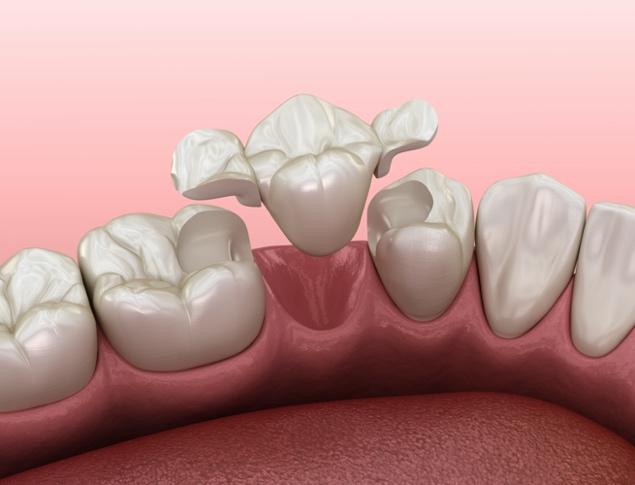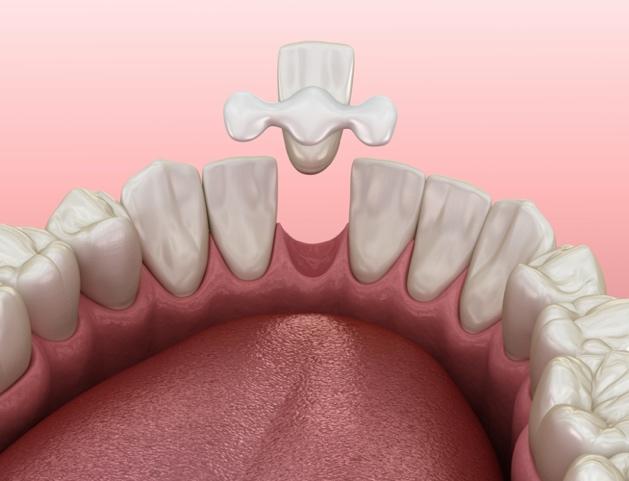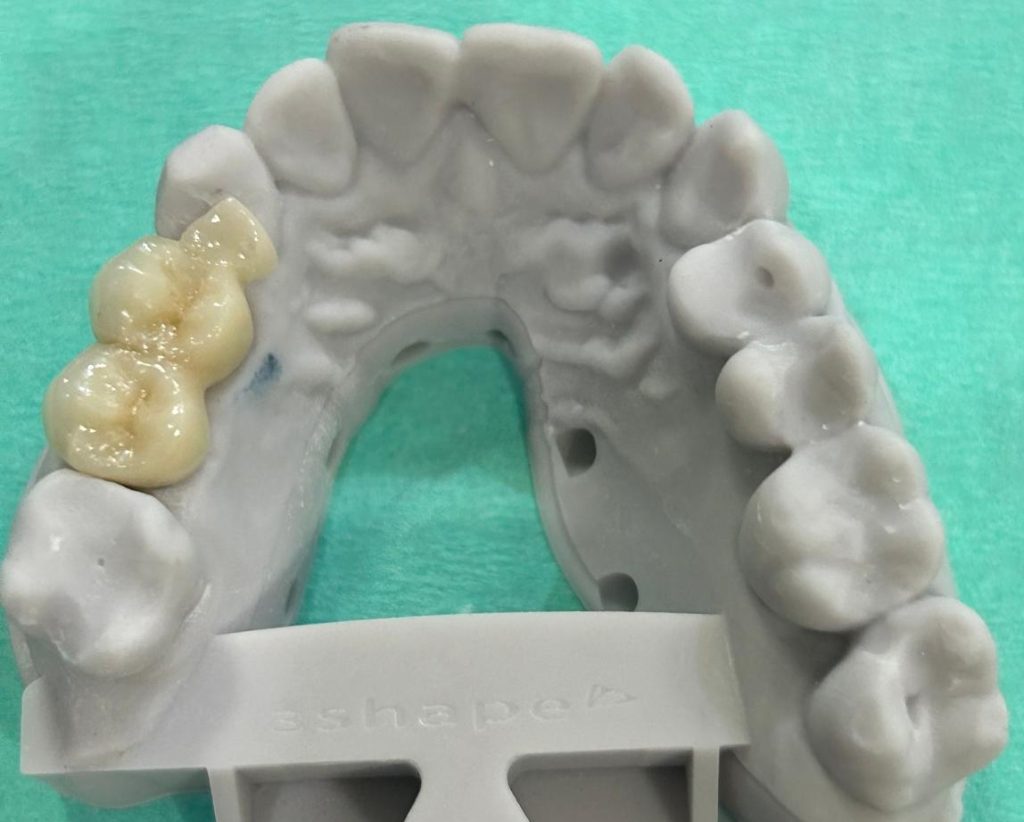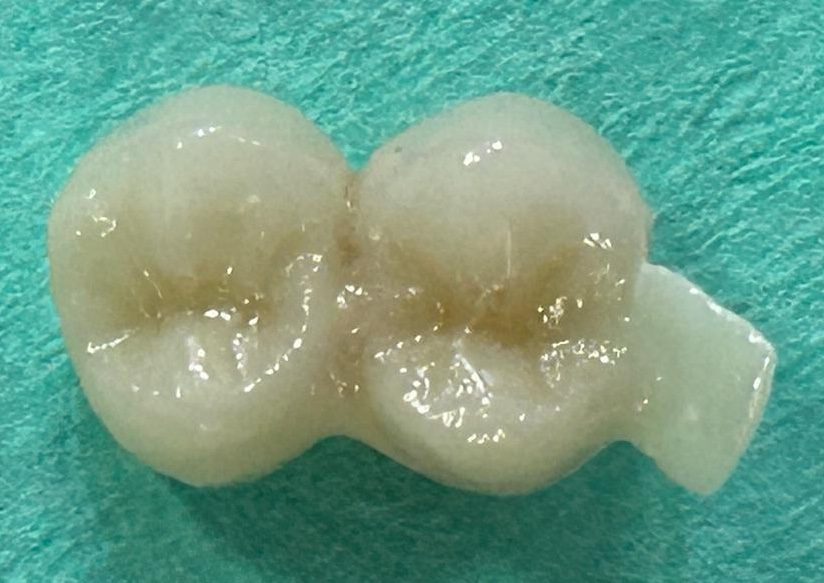What is a Maryland Dental Bridge?
Maryland bridges are a type of resin-bonded bridge, often recommended for replacing one missing tooth in the mouth. A Maryland bridge is a type of semi-permanent bridge that replaces one or two missing teeth in the front.
Maryland bridges are retained by metal, Zirconia or polymer wings instead of a full crown to secure this type of bridge on one side or both sides of the replacement tooth/teeth (pontic), which is anchored using a metal or porcelain framework bonded to the back of the surrounding tooth/teeth.
The wings are cemented or bonded to the retaining teeth or abutments on each side. Maryland bridges are more conservative compared to traditional bridges, as they require minimal preparation of the adjacent teeth.
Dentists typically use Maryland bridges to replace front teeth. These appliances aren’t strong enough to withstand the posterior chewing forces of back teeth in patients with severe grinding and clenching or excessive bite forces. Therefore, a special design should be made to wrap around the wings semi-circularly to the back teeth on two neighbouring teeth.

Dr. Nico Kamosi

Dr. Nico Kamosi
Specialist Periodontist, Implantologist, Prosthodontist, Holistic and Biological Dentist
TDL. DDS. (Swe.), MSc.Perio.(Eng.),
MClinDent.Perio.(Eng.), MSc.Imp.Dent.(Eng.),
Dip.Aesth.Med. (Eng.), MClinDent.Prosth.(Eng.),
Cert., Dip.DHSLM.(RCS.Eng.), Cert.Orth.(Eng.), Cert.Law (Eng.), AIAOMT
Accredited member of IAOMT, SMART Certified
Member of AACD, EFP, AAP, ESCI, IAOMT
When is a Maryland Bridge Recommended?
-
Missing teeth due to oral trauma or congenital causes in growing patients, before the placement of an implant, can be planned in patients with fully grown jaws.
-
Missing teeth when the patient is not a candidate for the dental implant procedure due to, e.g., medical contraindications, mental incapacity, insufficient bone volume or density, angled adjacent teeth roots, or financial limitations.
-
Intact neighbour teeth should not be prepared/damaged for the sake of a replacement tooth.
-
Ongoing complex rehabilitation cases involving orthodontic treatment.
-
Cancer patients with a limited amount of bone for dental implants.
-
Patients with Ectodermal dysplasia or hypodontia with a limited amount of bone for dental implant.
-
Patients with cleft palate/lip require a bridge as part of a multidisciplinary approach.
-
When the best choice is a Maryland bridge.


- What are the advantages of a Maryland bridge?
- Minimally invasive: Unlike traditional bridges, Maryland bridges do not require extensive removal of tooth enamel. They require minimal tooth preparation and are less invasive and atraumatic to the neighbouring teeth supporting the bridge. This would reduce the future risk of pulp trauma and necrosis, hence the need for root canal treatment. The tooth abutments are mostly left intact, and in case of an existing filling, they can be prepared as a supporting base for the bridge
- Comfortable fit: Typically, Maryland bridges fit comfortably without causing discomfort once bonded in place.
- Aesthetics: They can be customised to match your teeth’s natural colour and shape, providing a seamless and natural-looking smile.
- No anaesthesia: This type of minimally invasive tooth preparation may require no anaesthesia.
- Tissue friendly: Due to its minimalist design, it causes less gum irritation and violation of the periodontal tissue.
- Versatility: An ideal option for patients who are too ill or need invasive dental procedures or surgeries; hence, no surgery is needed.
- Interim long-term solution: An ideal provisional replacement option for patients who plan to undergo the implant procedure.
- Financially affordable: an ideal alternative option for patients who can’t afford an implant.
What are the disadvantages of the Maryland bridges
- Flexural strength: not as robust and durable as traditional bridges, although it preserves the actual supporting tooth better in the long term. Traditional bridges may be stronger, particularly for areas with increased biting forces.
- De-bonding: The three most common complications associated with the resin-bonded prosthesis are frequent de-bonding of the wings from the retainer teeth (21%), especially in the lower posterior regions with heavy chewing forces; tooth discolouration (18%) and caries (7%).
- Limitation of support: It is mainly indicated to replace only one missing tooth
- Aesthetic disadvantages: When the enamel is thin, the metal-backing bridges may make the neighbour’s teeth look darker.
- The metal-based false tooth (pontic) may lack adequate natural translucency and vitality.
- Tooth preparation: When there is little or no space between the upper and lower teeth, some minimal enamel surface preparation may be required on the supporting tooth, especially in patients with deep bites.
Maryland bridges vs. conventional bridges
- Aesthetics: Both types can be customised for an excellent natural appearance, especially when they have a Zirconia base and porcelain coverage, though traditional bridges might offer slightly better aesthetics.
- Conservative Approach: Maryland bridges preserve more natural tooth structure.
- Supporting teeth: Conventional bridges are supported on full crowns on the adjacent teeth
- Cost: Maryland bridges are typically more cost-effective because less dental work is required.
- Strength and Stability: Traditional bridges offer greater strength and stability.
- Longevity: Traditional bridges offer 10–15+ years of longevity compared to 5–10+ years for Maryland bridges
What Alternatives Exist to Maryland Bridges?
- Cantilever bridges are an alternative, especially when only a single adjacent tooth is missing. These bridges only require a single abutment adjacent tooth for support.
- Dental Implant is a more permanent solution for tooth loss. In addition to being more time-consuming and expensive, dental implants also require surgery and a longer healing period.
- Removable Partial Denture is a more economical option, but it can cause deleterious effects on the adjacent tooth’s gum health when incorrectly designed.
An updated tooth-conservative technique for the replacement of one missing tooth
Most of us, when we lose a tooth, are convinced that a dental implant or a traditional full bridge is the only option.
But knowing that a Hybrid metal-free Bridge supported on one abutment crown and one bonded wing combines biological tooth preservation, zirconia strength, and aesthetics.
When there is an existing neighbour crown, this type of bridge allows us to replace a missing tooth without drilling or crowning the adjacent front tooth. The wing, usually made from high-strength zirconia or lithium disilicate ceramic, is bonded to the non-prepared tooth, typically a front tooth. This technique offers a hybrid support system, with mechanical support on one side.
Why Choose a Hybrid Bridge?
You will be a good candidate for a hybrid bridge design when you are missing a single tooth in the front or premolar region. The mechanically supporting crown is usually placed on an existing crown or a large filling that requires a protective crown. The other healthy adjacent tooth should remain intact. A hybrid bridge provides you with a fixed, natural-looking tooth replacement in case surgery or a dental implant is not the best option for you.



How painful is the treatment process of getting a Maryland bridge?
How Long Does it take to get used to a Maryland Bridge?
What are the different types of Maryland Bridges?
Zirconia Maryland bridge
A zirconia Maryland bridge mimics the colour of natural teeth, offering good performance in both aesthetic and strength aspects. These metal-free bridges are biocompatible, have excellent aesthetics, and have a success rate of ca. ~92%.
Preparation-free fibre-reinforced composite bridges.
The fibre-reinforced composite (FRC) bridge is a new method for replacing missing teeth. This conservative technique uses glass strands/bundles to scaffold the composite pontic, bonded to the adjacent abutment teeth.
What are the Advantages of fibre-reinforced composite (FRC) bridges?
- Minimally invasive, reversible, and non-destructive to the healthy enamel and dentin
- Can be used for temporary, medium-term and long-term solutions.
- Aesthetically natural and pleasing
- Cost-effective way to restore missing tooth; they are affordable and durable
- Can be constructed based on the direct technique in one session when the direct technique is performed
- Same-day chairside restorations can be easily repaired in one session in case of fracture.
- Simple and quick; Ideal option for elderly patients.
- Have the interpenetrating polymer network (IPN) with excellent bonding to composite materials, adhesives and resin types of cement.
Metal Framework Bridges
What are the success rates for the Maryland bridges?
- Maryland bridges are considered permanent but may not last a lifetime.
- The clinical data reveal that Maryland bridges have been a successful treatment option as a transitional and permanent prosthesis for over three decades.
- Several studies indicate that anterior bridges tend to have a better performance than posterior bridges.
- The overall survival rate has been suggested to be around 77% after ten years of service.
- An estimated 5-year success rate of Maryland bridges is ca. 88.18% with metal framework and 84.41% with nonmetal framework.
- The success rate for zirconia materials is ca. 92.07%.
- The success rate of Maryland bridges with In-Ceram alumina is 94.26%.
- The success rate of Maryland bridges with Fibre-Reinforced Composite is 84.83%.
How can my dentist help extend the longevity of my bridges?
- Advise patients to avoid hard foods and bruxism without protection.
- Surface preparation utilising air abrasion and special primers.
- Ensure strict moisture control during bonding.
- Appropriate case selection, e.g., Zirconia-based in the anterior aesthetic. zone, metal-based in the posterior functional zone.
- Adequate surface and geometric dimension of abutments for sufficient support and retention.

